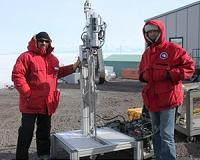 |
Leicester, UK (SPX) Nov 19, 2010 Scientists and engineers at the internationally acclaimed Space Research Centre at the University of Leicester are developing a conceptual motor design for a Mars 'hopping' vehicle which should lead to a greater understanding of the 'Red Planet'. Robots exploring Mars can carry scientific instruments that measure the physical and chemical characteristics of the Martian surface and subsurface, analyse the environment and look for evidence of past or present life. Wheeled rovers have made extraordinary discoveries despite only exploring a small fraction of the planet. The research has an international flavour. The University of Leicester has been working with a number of collaborators including Astrium Ltd in the UK and Center for Space Nuclear Research, Idaho, USA. The focus in the UK has been the development of a large-scale (400 kg) Mars Hopper concept that can fly in 1km 'hops'. This is an exciting concept that should be considered further as a complement to rover and orbital missions. The Hopper can collect fuel between hops by compressing gas from the Martian atmosphere and can fly quickly between sites, powered by a long-life radioisotope power source. It could therefore study hundreds of locations over a lifetime of several years. The Leicester research focused on the rocket motor, looking at its size and materials. Dr Richard Ambrosi, at the Leicester Space Research Centre, commented: "The improved mobility and range of a hopping vehicle will tell us more about the evolution of Mars and of the Solar System and may answer questions as to whether there was life in the past, whether Mars was wetter in the past and if so where that water went." Dr Nigel Bannister added: "The Hopper is different from other rovers because of its power source. In one mode the heat source generates electric power to drive a compressor to gather the carbon dioxide propellant from the Martian atmosphere. The heat source then stores thermal energy and injects it into the propellant, which is accelerated out of a rocket nozzle to provide thrust." Dr Hugo Williams said: "At Leicester we have concentrated on the motor and design features which translate into the performance of the vehicle. "Our findings have resulted in a hop range of 1km, for a relatively large vehicle with a large suite of scientific instruments on board. We also looked at the geometry and the best materials for the motor core. "Our interest in the materials aspect is particularly relevant because we are also engaged in collaborative research with our colleagues in Materials Engineering here at Leicester, and Queen Mary University of London to explore how material properties of materials for use in the space nuclear systems of the future can be enhanced through novel processing and manufacturing techniques."
Share This Article With Planet Earth
Related Links University of Leicester Mars News and Information at MarsDaily.com Lunar Dreams and more
 IceBite Blog: Setting Up An IceBreaker
IceBite Blog: Setting Up An IceBreakerMoffett Field CA (SPX) Nov 18, 2010 Since the arrival to the McMurdo station in the Antarctic two days ago, most of our time has been spent on assembling and testing our Mars prototype drill: the Icebreaker. Icebreaker was built to break into the hard icy soil of Mars. On our first day at the McMurdo station we went to our laboratory and found that only two out of the eight boxes we shipped to Antarctic two months ago actual ... read more |
|
| The content herein, unless otherwise known to be public domain, are Copyright 1995-2010 - SpaceDaily. AFP and UPI Wire Stories are copyright Agence France-Presse and United Press International. ESA Portal Reports are copyright European Space Agency. All NASA sourced material is public domain. Additional copyrights may apply in whole or part to other bona fide parties. Advertising does not imply endorsement,agreement or approval of any opinions, statements or information provided by SpaceDaily on any Web page published or hosted by SpaceDaily. Privacy Statement |